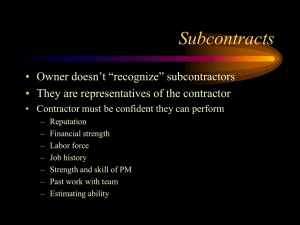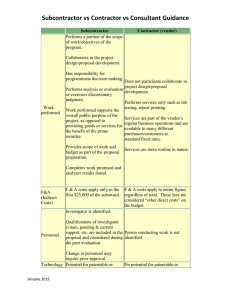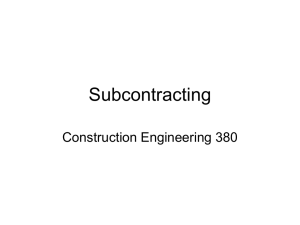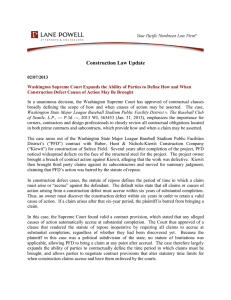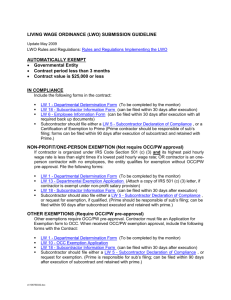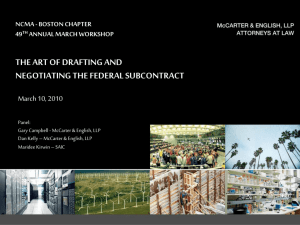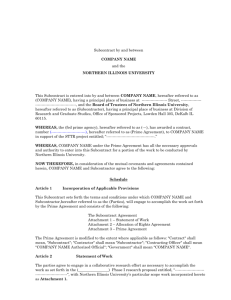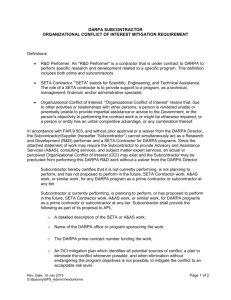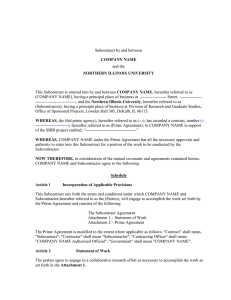Subcontracts 101 Presentation
advertisement
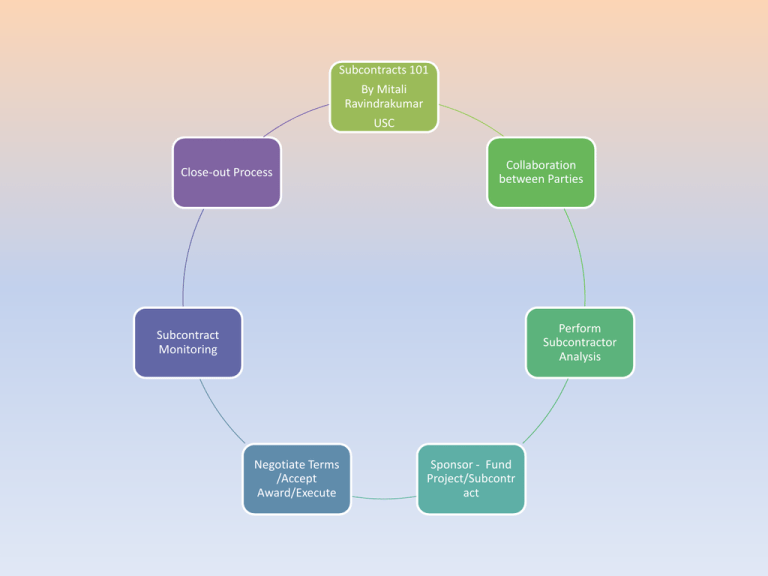
Subcontracts 101 By Mitali Ravindrakumar USC Close-out Process Collaboration between Parties Perform Subcontractor Analysis Subcontract Monitoring Negotiate Terms /Accept Award/Execute Sponsor - Fund Project/Subcontr act Overall Process: Before consenting to a subcontract, the Sponsoring Agency reviews the request and supporting data provided by the prime and considers such factors as: technical need for services, compliance with the prime contract's goals, adequacy of competition, responsibility of the proposed subcontractor, proposed type and terms and conditions of the subcontract, and adequacy and reasonableness of cost or price analysis performed. Prime contractors are responsible for planning, awarding, and administering its subcontracts. Subcontractor vs. Service Order Independent Contractor: offers services to the general public on a consistent basis for a specified amount of compensation for a specified result. Prime contractor does not control the methods used to obtain the results Consultant: an individual who provides professional or technical advice, opinions, or services to the prime contractor for a fee. Subcontractor: an individual or organization identified by a prime contractor to perform a specific task as part of the overall research project. Performing the Subcontractor Analysis: Collaboration Agreements- proposed in the application and included/approved in the award document. Sole source - implies that there is only one person or company that can provide the contractual services needed and that any attempt to obtain bids would only result in one person or company being available to meet the need. Competition - Selections subject to the competitive evaluation process (preaward): the technical capability and costs of proposed subcontract teams are evaluated as a combined entity. Consent- Requires sponsor approval (postaward) non-team subcontracts are usually consented to by letter Directed Subcontracting- sponsors are prohibited from directing or assisting prime contractor in selecting subcontractors, or personnel to be used on a subcontract. Funding / Issuing Subcontracts: Collect and update all required Certifications (Debarment, Lobbying, etc.) A-133 Audit Compliance Confirm Rates, As part of cost analysis (labor, F&A, Fringe, Stipend, etc.) Ensure that contact has been established with subcontractor’s Business Office Negotiate Terms and Conditions: FDP: use of accepted terms and conditions / approved forms and sponsorspecific attachments Non-FDP: Use Institutional Subcontract template (if you have one) and /or prime agreement’s terms and conditions. Certificate of Current Pricing Data FAR Part 15 – cost determination Terms in accordance with Public Law 87-563/ Truth in Negotiation-terms TITLE to Equipment, Copyrights, Data Ownerships, Invoicing requirement Flow down clauses or specific requirements from prime agreement. Monitoring: Collect Representations and Certifications PI or designee performs Technical Review Department of Contracts and Grants or other postaward unit performs Administrative Review-Collect and review Invoices for payment Disbursement Control issues checks and mail out payments Any Modifications and Amendments are also processed as needed based on technical direction from PI and terms of prime agreement. Closeout: Federal: All federal contracts to say the following before close-out: “The Subcontractor assures to the University that all expenses were incurred in full compliance with Federal cost principles (i.e., OMB Circular A-110 and A-122 and its own internal applicable audit regulations. Disallowed cost if found during the retention period of subcontract will promptly be refunded to the University.” Collect final reports (i.e., technical, financial, invention reports and property report as required by the Prime Sponsor Subcontractor may be required to send Final Claim and Release Form to Contractor Records Retention-closeout guidance taken from Federal cost principals. Additional instructions, based on prime contract, should be included in the terms of the Subcontract.
